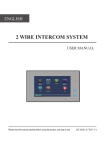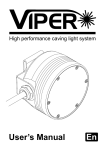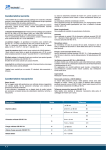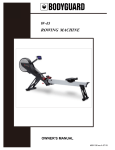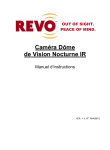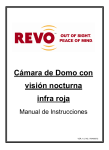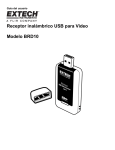Download Customidea GeoPic II Technical information
Transcript
Geotagging Device With three intelligent modes of operation including low-power and freeze mode Suitable for: Nikon D200/D2HS/D2X/D2XS Fuji S5 Pro 1 Contents Contents Introducing the GeoPic II ………………………………… 2 Quick start guide ……………………………….………… 3 GeoPic II overview ……………………………….………. 4 GeoPic II basic operation ………………………….…….. 5 Continuous mode (red) ………………………….………. 7 Low power mode (green) ………………………….…….. 8 Freeze mode (blue) ………………………….…...…….. 10 Remote shutter release …………………….…...……. 14 GeoPic II user settings ……………………….…...……. 15 Technical information ……………………….…...……... 18 WARNINGS: Keep out of reach of children The product is not suitable for use by children under 14 years of age. Only connect suitable attachments The remote shutter release socket on the product is only suitable for remote shutter releases which are described on page 14 of this booklet. If a non compatible remote shutter release is used it may damage the product and camera. Avoid contact with water The product is not waterproof so avoid getting it wet. If it does get wet then disconnect the unit from the camera and leave to dry in a warm place for 24 hours. Do not disassemble In the event of a faulty device contact Custom Idea Ltd. Touching the internals of the device could result in injury. If the product breaks open due to an accident then disconnect it immediately from the camera and contact Custom Idea Ltd. Unplug immediately in the event of a malfunction Should you notice the product not functioning correctly, then unplug it immediately and contact Custom Idea Ltd. Nikon D200, D2HS, D2X and D2XS and Fuji S5 Pro are registered trademarks or a trademark of their respective companies. 2 Introducing the GeoPic II Introducing the GeoPic II Congratulations on your purchase of the GeoPic II, one of the world’s most advanced geotagging solutions for digital SLR cameras! Geotagging is an exciting new area of photography that involves attaching geographical location ‘tags’ to your digital photos. An increasing amount of software is becoming available to take advantage of these tags, for example by placing your photos on a geographical map. Some DSLR cameras, in particular the Nikon D200, D2HS, D2X, D2XS and Fuji S5 Pro, have the potential for geotagging built in as standard, and just require a suitable GPS device to be attached to their 10-pin accessory socket. However, a problem with many of these GPS devices is that they reduce your DSLR battery life, not only due to the GPS device itself taking power, but also because the DSLR is forced to stay continuously in its high-power metering state. Thanks to patent pending low power technology in the GeoPic II, attaching a GPS device no longer means flat batteries after just a few hours. Furthermore, the GeoPic II has a mode of operation that allows photos to be geotagged whilst out of contact with the satellites. With a high performance SiRF III chipset and configurable options and settings, the GeoPic II really does represent the cutting edge of the DSLR geotagging market. Not only does all this technology come in a tiny enclosure but it is also incredibly easy to use. This handy booklet contains everything you need to know about your GeoPic II, but if you want to jump right in, then a quick start guide has been included on page 2. Nikon D200, D2HS, D2X and D2XS and Fuji S5 Pro are registered trademarks or a trademark of their respective companies. Quick start guide 3 Quick start guide The GeoPic II is powered up or down by pressing and holding the function button and it starts up in the mode you last used. The three modes of operation are called continuous, low power and freeze mode, and can be changed by half pressing the shutter release button then pressing the function button: OF F Each mode has its own colour and operates as follows: Mode: Description Continuous GPS location is continuously sent to the camera if locked to the satellites. The status light will slowly flash red when there is no lock and be continuously red if there is. Low Power GPS location is sent to the camera if locked to the satellites AND shutter release button is half pressed. When unlocked the status light will slowly flash green. When locked the status light will only occasionally blink green to let you know it is ready. GPS location will be sent to the camera the moment the shutter release button is half pressed. Wait until the beep and the green light is lit to take the picture. Freeze GPS location is frozen on demand in an internal buffer. Press the function button to start a new search and freeze a new location. Cancel a search by pressing the function button again. When searching for a new location, the status light will slowly flash blue. When a location is frozen the status light will occasionally blink blue to let you know it is ready. GPS data will be sent to the camera the moment the shutter release button is half pressed, in the same manner as the low power mode. Wait until the beep sounds, and the blue light is lit to take the picture Nikon D200, D2HS, D2X and D2XS and Fuji S5 Pro are registered trademarks or a trademark of their respective companies. 4 GeoPic II overview GeoPic II overview The GeoPic II is designed to be extremely compact and very simple to use, so you can spend time on your photography instead of being confused by a new gadget. A function button is used along with your camera shutter release button to access all of the GeoPic II features. A multicoloured light indicates the current state of the system. The GeoPic II simply slots into the flash mount on your camera and connection is achieved through a high quality 10-pin lead. The GeoPic II has three modes of operation, which are explained in detail in later sections: Mode: Power: Colour: Continuous Short battery life Description Red GeoPic II continuously sends GPS location to the camera if locked to the satellites. Camera never leaves metering state. Low Power Long battery life Green GeoPic II only sends GPS location to the camera if locked to the satellites AND shutter release button is half pressed. Camera can leave metering state. Freeze Super long battery life† Blue GeoPic II freezes the GPS location, on demand, in an internal buffer and uses this data to send to the camera. Can select to send GPS location to camera when shutter release button is half pressed, or continuously as required. † Super low power if set to send GPS data when shutter release button is half pressed Nikon D200, D2HS, D2X and D2XS and Fuji S5 Pro are registered trademarks or a trademark of their respective companies. GeoPic II basic operation 5 GeoPic II basic operation Slide the GeoPic II into the hotshoe flash mount on your camera, and with the camera off, connect the 10-pin connector to the matching socket on the camera body. The locking ring can be used to secure the connection. Press and hold the function button for a second or two and you will see the GeoPic II spring to life. There are a number of different ways that the GeoPic II can be powered up and powered down. When the GeoPic II powers up, the status light will slowly turn on in the colour corresponding to the last used mode. When the GeoPic II powers down, the status light will slowly turn off in the colour of the currently used mode. The following table explains the different power up and power down methods: Power up method: Details Press and hold function button Pressing and holding the function button on top of the unit for approximately 2 seconds will turn on the GeoPic II. You can disable this power up method from the settings menu if required. Camera entering metering state The GeoPic II will turn on if the camera enters its metering state. This will happen if you turn on the camera, or if you press the shutter release button to wake the camera up. You can disable this power up method from the settings menu if required. Power down method: Details Press and hold function button Pressing and holding the function button for approximately 2 seconds will turn off the GeoPic II. Auto off after inactivity The GeoPic II will turn off after a certain period of inactivity from the camera, the default is 5 minutes. If required, you can disable this power down method from the settings menu, or change the period of inactivity to between 1 and 10 minutes. Nikon D200, D2HS, D2X and D2XS and Fuji S5 Pro are registered trademarks or a trademark of their respective companies. 6 GeoPic II basic operation You can change between the continuous, low power and freeze modes of operation by holding the camera’s shutter release button at the half pressed point then pressing the GeoPic II function button. Each time you do this the GeoPic II will change modes, from continuous to low power to freeze and back to continuous. OF F To make it clear which mode is currently selected, the status light will always be a red colour in continuous mode, a green colour in low power mode and a blue colour in freeze mode. To save you time, the GeoPic II remembers the mode you last used and when you power it up will automatically enter that mode. Nikon D200, D2HS, D2X and D2XS and Fuji S5 Pro are registered trademarks or a trademark of their respective companies. Continuous mode (red) 7 Continuous mode (red) This section explains how the GeoPic II behaves in its continuous mode of operation. In this mode, the status light will always be a red colour. The continuous mode is the most basic mode of operation. If GPS data is available, the GeoPic II will continuously update the camera with the current location. Data is sent regardless of the state of the camera: Status light: Function button: Description No function The GeoPic II does not have a sufficient lock on the satellites, and is not sending any GPS data to the camera. The camera’s GPS icon will not be visible in its display. (Mode change with half press) slow flashing No function always on (Mode change with half press) The GeoPic II has locked to three or more satellites and is continuously updating the camera with the GPS location. The camera’s GPS icon will be visible in its display. The time that the GeoPic II takes to achieve a good lock on the satellites will depend on a number of factors. Typical lock times are given in the technical details at the end of this manual. Once the GeoPic II is locked, any pictures taken with your camera will be geotagged with the current GPS location. You will notice that when the GeoPic II is in the continuous mode and locked, the camera will not leave its metering state (i.e. where metering information is shown on the camera LCD). Since the camera uses far more power in metering state than standby state, the battery life in continuous mode will be significantly reduced. This is not the case in the low power mode which is discussed in the next section. Nikon D200, D2HS, D2X and D2XS and Fuji S5 Pro are registered trademarks or a trademark of their respective companies. 8 Low power mode (green) Low power mode (green) This section explains how the GeoPic II behaves in its low power mode of operation. In this mode, the status light will always be a green colour. The low power mode of operation ensures that GPS data is only sent to the camera when the user is getting ready to take a picture. It does this by only sending GPS data when the shutter release button is half pressed: Status light: Function button: Description: No function The GeoPic II does not have a sufficient lock on the satellites, and is not sending any GPS data to the camera. The camera’s GPS icon will not be visible in its display. (Mode change with half press) slow flashing No function (Mode change with half press) occasional blink No function (Mode change with half press) always on The GeoPic II has locked to three or more satellites and is ready to send GPS data to the camera. An occasional green blink shows that the GeoPic II is ready to send GPS data when necessary. The moment the shutter release button is pressed half way, the GeoPic II will send GPS data to the camera. The camera GPS icon will not be visible in its display. If the GeoPic II is locked and the shutter release button has been pressed half way then the status light will be lit the moment the camera has been sent enough GPS data to begin geotagging photos. When this happens the GeoPic II will emit a short beep (this can be disabled if desired) and the camera’s GPS icon will be visible in its display. In the low power mode, the short beep and the green status light turning on indicates that sufficient GPS data has been sent to the camera for it to start geotagging photos. Once this happens you can be confident that your photos will be geotagged successfully. Nikon D200, D2HS, D2X and D2XS and Fuji S5 Pro are registered trademarks or a trademark of their respective companies. Low power mode (green) 9 There will be a fraction of a second delay from the moment you press the shutter release button half way until the camera is ready to geotag the photo. Therefore you must wait until the green light is lit before taking your photo. A beep coincides with the green light, meaning that there is no need to take your eye from the camera viewfinder to know that the camera is ready. You will notice that in the low power mode, your camera will happily leave its high power metering state when it has seen no activity for a period of time. This is the reason for the significantly increased battery life whilst in the low power mode, because the camera uses only a tiny amount of power in its standby state. Note that the GPS module within the GeoPic II is constantly on during the low power mode, so the power consumed by the GeoPic II does not change. Power is reduced by allowing the camera to enter standby state. The following figures represent typical photo counts you can expect in low power mode. Bear in mind that these numbers will depend on your shooting style and camera setup: Mode: Current consumption: GeoPic II: ~55mA Continuous Camera: ~300mA Total: ~355mA regardless of state. Low power No GPS attached † Photos: 315 † † GeoPic II: ~55mA Camera (standby/metering): ~0.1mA/300mA Total: (standby/metering): ~55.1mA/355mA 970 Camera (standby/metering): ~0.1mA/300mA 1750 † 3 large res, basic quality JPEGs taken every 2 minutes (more details at end of manual) Nikon D200, D2HS, D2X and D2XS and Fuji S5 Pro are registered trademarks or a trademark of their respective companies. 10 Freeze mode (blue) Freeze mode (blue) This section explains how the GeoPic II behaves in its freeze mode of operation. In this mode, the status light will always be a blue colour. The freeze mode of operation keeps the last locked GPS location in a buffer and uses this to send to the camera, instead of live data. This is useful for two reasons, firstly, photos can be geotagged whilst in buildings and secondly the GPS module inside the GeoPic II is switched off in freeze mode making it the lowest power of all three modes. The default operation is as follows: Status light: slow flashing Function button: Description: Cancels the search and uses previously buffered location The GeoPic II has switched on its internal GPS module and is waiting for a good lock so that it can store this data in a buffer and use it for subsequent geotagging. The camera’s GPS icon will not be visible in its display. (Mode change with half press) Starts a new search, to update the buffered GPS location occasional blink always on (Mode change with half press) Starts a new search to update the buffered GPS location (can take a few seconds to see the request) (Mode change with half press) The GeoPic II has locked to three or more satellites and has buffered the GPS location. It has switched off the internal GPS module. An occasional blue blink shows that the GeoPic II is ready to send buffered GPS data when necessary. The moment the shutter release button is pressed half way, the GeoPic II will send the buffered GPS location. The camera GPS icon will not be visible in its display. When the shutter release button has been pressed half way then the status light will light the moment the camera has been sent enough GPS data to begin geotagging photos. When this happens the GeoPic II will emit a short beep (this can be disabled if desired) and the camera’s GPS icon will be visible. Nikon D200, D2HS, D2X and D2XS and Fuji S5 Pro are registered trademarks or a trademark of their respective companies. Freeze mode (blue) 11 To start a search for a new position, press the function button on the GeoPic II. This will cause the GPS module inside the GeoPic II to be powered up, until a new lock is achieved. The new GPS location will be buffered and the internal GPS module will switch off once more. The search for a new position can be cancelled by pressing the function button whilst the search is taking place, at which point the last buffered location will be reloaded into the buffer. If a search is cancelled when there is no previous data available (e.g. when you first receive the unit) then the GeoPic II will ignore the cancel request and continue to search. By default the GeoPic II will begin a new search when powered up in freeze mode. If you want to retain the last location you can cancel this search with the function button as just described. However, if required, the GeoPic II can be configured to not search by default on power up in freeze mode (see the settings section). In freeze mode, the short beep and lighting of the blue light indicates that sufficient buffered GPS data has been sent to the camera for it to start geotagging photos. There will be a fraction of a second delay from the moment you press the shutter release button half way until the camera is ready to geotag the photo. Therefore you must wait until the blue status light is lit before taking your photo. A beep coincides with the blue light meaning that you do not need to take your eye from the camera viewfinder to know that the camera is ready. This is identical operation to the low power (green) mode, except the GeoPic II uses buffered, not live GPS data. Nikon D200, D2HS, D2X and D2XS and Fuji S5 Pro are registered trademarks or a trademark of their respective companies. 12 Freeze mode (blue) There may be occasions when it is desirable to continually send buffered GPS data to the camera in the same way as the continuous (red) mode. This would result in higher power consumption, but there would be no delay before the camera is ready to geotag photos. This behaviour can be enabled if desired (see the setting section) and results in the following behaviour: Status light: slow flashing Function button: Description: Cancels the search and uses previously buffered data The GeoPic II has switched on its internal GPS module and is waiting for a good lock so that it can store this location in a buffer and use it for subsequent geotagging. The camera’s GPS icon will not be visible in its display. (Mode change with half press) Starts a new search, to update the buffered GPS data always on (Mode change with half press) The GeoPic II has good buffered data and is continuously updating the camera with the buffered GPS location. GPS data is sent regardless of the camera state. The camera’s GPS icon will be visible in its display. Provided that continuous sending of data in the freeze mode is not enabled, your camera will happily leave its high power metering state when it has seen no activity for a period of time. This contributes to significantly increased battery life whilst in the freeze mode, because the camera uses only a tiny amount of power in its standby state. Unlike the low power (green) mode, the GPS module within the GeoPic II is turned off during freeze mode (unless searching for a new position). The power consumed by the GeoPic II in freeze mode is therefore much lower than both the other modes of operation. This combined with the camera being allowed to enter its standby state results in the lowest overall power consumption. Nikon D200, D2HS, D2X and D2XS and Fuji S5 Pro are registered trademarks or a trademark of their respective companies. Freeze mode (blue) 13 The following figures represent typical photo counts you can expect in freeze mode. Bear in mind that these numbers will depend on your shooting style and camera setup: Mode: Current consumption: GeoPic II: ~55mA Continuous Camera: ~300mA Total: ~355mA regardless of state. Photos: 315 † † GeoPic II: ~55mA Camera (standby/metering): ~0.1mA/300mA Total: (standby/metering): ~55.1mA/355mA 970 Low power GeoPic II: ~2mA Camera (standby/metering): ~0.1mA/300mA Total: (standby/metering): ~2.1mA/302mA 1690 † Freeze Camera (standby/metering): ~0.1mA/300mA 1750 No GPS attached † † 3 large res, basic quality JPEGs taken every 2 minutes (more details at end of manual) It is useful to have a means of recording whether a photo was taken in freeze mode, to make it clear that the geotag may not be accurate. For this reason a user setting is available that replaces the altitude field of the geotag with the value of ‘99999m’. If you would like to enable this option then please see the settings section. It is important to note that buffered GPS data in freeze mode is never replaced in either the continuous (red) or low power (green) modes. Consider the scenario when the GeoPic II is in low power (green) mode and locked, then you subsequently change to freeze mode. The GPS data from low power mode will not be used in freeze mode. Instead you can either wait for freeze mode to obtain a lock and replace its buffered location or cancel the search and use the data from the last time you obtained a lock in freeze mode. Nikon D200, D2HS, D2X and D2XS and Fuji S5 Pro are registered trademarks or a trademark of their respective companies. 14 Remote shutter release Remote shutter release Every GeoPic II is provided with a fully functional remote shutter release socket. The socket is a 2.5mm jack socket which is compatible with standard remote shutter release cords available in shops and online. Custom Idea sells a suitable remote shutter release cord on our website at a very reasonable price. If you purchase a remote release cord from another supplier then make sure the signals follow the standard below: Nikon D200, D2HS, D2X and D2XS and Fuji S5 Pro are registered trademarks or a trademark of their respective companies. GeoPic II user settings 15 GeoPic II user settings The GeoPic II has a total of eight user settings, each with different options that can be configured to suit your needs. The settings menu is accessed from any mode by holding the shutter release button half way and pressing the function button on the GeoPic II for around 5 seconds. As the settings menu is entered, the status light flashes white twice. Navigating the setting and option menus is achieved by using the function button and the shutter release button: When in settings menu: When in options menu: Half press shutter release Changes to the next setting (wraps around from the last to the first setting) Changes to the next option (wraps around from the last to the first option) Function button Enters the option menu for the current setting. This is confirmed by a single red/green flash corresponding to the first option for this setting. Saves the current option to memory. This is confirmed by a beep and a number of green flashes corresponding to the option number. Full press shutter release Exits the settings menu and returns to normal operation. This is confirmed by two white flashes. Exits the option menu and returns to the settings menu. This is confirmed by a number of blue flashes corresponding to the setting number. Status light A number of blue flashes corresponding to the setting number. A number of flashes corresponding to the option number. Flash colour will be green if option is currently in use or red otherwise. The eight settings and options for these settings are as follows (default option is green): Nikon D200, D2HS, D2X and D2XS and Fuji S5 Pro are registered trademarks or a trademark of their respective companies. 16 GeoPic II user settings Setting: Option: Description: 1 1 Enables the beep in low power and freeze modes. Beep 2 2 Auto off 1 2 3 4 5 3 Button† 1 2 4 † Meter 1 2 5 Blink 1 2 6 Continuous 1 2 7 Alt. Field 1 2 8 Search 1 2 Enabled Disabled 1 min 2 mins Enables the auto power down after the period of inactivity chosen. 5 mins 10 mins Disabled Enabled Disabled Enabled Disabled Enabled Disabled Enabled Disabled Enabled Disabled Enabled Disabled If enabled, the function button will power up the GeoPic II. If enabled, the GeoPic II powers up when camera wakes up. Enables the green/blue blink in low power and freeze modes. Enables continuous sending of GPS data in freeze mode. If enabled, in freeze mode the altitude field is set to 99999m. Enables searching on power up in freeze mode. † If setting 3 is disabled then setting 4 will be automatically enabled and vice versa - this is to avoid a situation where it is not possible to turn on the unit. Changing the settings is easy once you get used to it – try going through the following example, which shows how to change the Auto off setting (setting 2) to 10 minutes (option 4): 1) Press and hold the shutter release button half way then press the function button for around 5 seconds to enter program mode. Two white flashes confirm that program mode has been entered and the following single blue flash shows you that setting 1 is selected. Nikon D200, D2HS, D2X and D2XS and Fuji S5 Pro are registered trademarks or a trademark of their respective companies. 17 GeoPic II user settings 2) Half press the shutter release button once to move from the current setting (setting 1) to setting 2. Two blue flashes confirm setting 2 is selected. Press the function button to enter the option menu for setting 2. A single red flash confirms you are at the first option for setting 2. OF F 3) Half press the shutter release button three times to move from the current option (option 1) to option 4. With each half press, the next option is selected and confirmed with a number of flashes. Option 3 flashes in green because it is the currently configured option. OF F OF F OF F 4) Save option 4 by pressing the function button. This is confirmed by a beep and 4 flashes corresponding to the option number. The flashes will be green because this is now the currently configured option. 5) Fully press the shutter release button to return to the settings menu. This is confirmed by two blue flashes, showing we are still at setting 2. Fully press the shutter release button again to exit from the settings menu and return to normal operation. This is confirmed by two white flashes, and normal operation is resumed. Nikon D200, D2HS, D2X and D2XS and Fuji S5 Pro are registered trademarks or a trademark of their respective companies. 18 Technical information Technical information Physical: Dimensions 35mm x 58mm x16mm Lead length 22cm Connector 10-pin with locking ring Remote socket 2.5mm jack Power consumption Current (on) ~55mA GPS on, ~2mA GPS off Current (off) <10µA GPS module: Module type SiRF III Channels 20 channel all in view tracking Sensitivity -159dBm Accuracy 10m, 5m WAAS available WAAS Enabled by default GPS time UTC (GMT) time Cold start 42 sec average Warm start 38 sec average Hot start 1 sec average Re-acquisition 0.1 sec average Output message NMEA: GGA, RMC Photo count test setup: Camera model Nikon D200 Battery Fully charged fresh Nikon EN-EL3e Photo interval 3 photos, 5 seconds apart, every 2 minutes Picture quality Large resolution, basic compression JPEG LCD settings LCD preview turned off Lens 50mm f/1.8 Nikon Error warnings: Slow RGB flash Settings are corrupt so GeoPic II has automatically reloaded the default options. To continue, reset the unit by disconnecting from the camera and reconnecting after a few minutes. Nikon D200, D2HS, D2X and D2XS and Fuji S5 Pro are registered trademarks or a trademark of their respective companies. Introducing the GeoPic II Custom Idea’s newly released geotagging device, the GeoPic II is one of the most sophisticated geotagging solutions for digital SLR cameras in the world. A problem with many DSLR GPS devices is reduced battery life, not only due to the GPS device itself, but also because the DSLR is prevented from entering its low power sleep state. However, thanks to patent pending low power technology in the GeoPic II, this problem has now been solved. In total the GeoPic II has three modes of operation, including a low power and freeze mode. Freeze mode keeps the GPS position in an internal buffer, allowing you to geotag photos even when out of sight of the satellites, for example when indoors. Not only does all this technology come in a tiny enclosure but it is also incredibly easy to use. With an integrated high performance SiRF III chipset, a remote release socket and many configurable options and settings, the GeoPic II truly represents the cutting edge of the DSLR geotagging market. Mode: Description Photos Continuous GeoPic II continuously sends GPS data to the camera if locked to the satellites. Camera never leaves metering state – this is equivalent to other units on the market. 315 Low Power GeoPic II only sends GPS data to the camera if locked to the satellites AND shutter release button is half pressed. Camera can leave metering state resulting in large power savings over other units on the market. 970 Freeze GeoPic II freezes the GPS position on demand in an internal buffer and uses this data to send to the camera. This saves even more power and allows you to geotag photos whilst out of sight of satellites (e.g. indoors). 1690 www.customidea.com




















